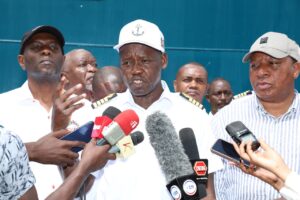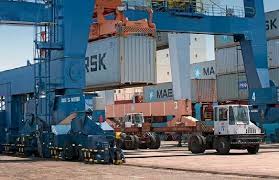Bold Step Toward Smarter, Safer, and More Competitive Port of Mombasa

one of the newly acquired state-of-the-art multipurpose boats
By Andrew Mwangura
Email, thecoastnewspaper@gmail.com
The Port of Mombasa, East Africa’s maritime gateway and a lifeline for regional trade, has taken yet another bold step toward operational excellence with the acquisition of two state-of-the-art multipurpose boats—MT Manda and MV Mrembo. This milestone marks a major leap in the Kenya Ports Authority’s (KPA) modernization agenda, reinforcing the port’s reputation as a competitive, efficient, and forward-looking maritime hub.
Speaking during the official reception of the vessels, KPA Chairman Hon. Benjamin Tayari underscored the acquisition as a key pillar in the Authority’s strategy to enhance port safety, efficiency, and service delivery. His remarks were not mere ceremonial words but a reaffirmation of a long-term vision—to transform Mombasa into a smart, world-class port capable of competing with global maritime centers. The introduction of these multipurpose boats is therefore not just about adding hardware to the fleet; it is about redefining how the port operates, responds, and innovates in a dynamic maritime environment.
Modern ports are increasingly judged not only by the volume of cargo they handle but also by the speed, safety, and sophistication of their operations. In this context, the MT Manda and MV Mrembo represent more than technological assets—they are strategic enablers. They embody the Authority’s quest to reduce vessel turnaround times, lower shipping costs, and bolster Kenya’s position as the preferred logistics gateway to the East and Central African hinterland. As Chairman Tayari rightly observed, efficiency at the port directly translates into lower costs for shippers and faster cargo clearance, which in turn makes the Northern Corridor more competitive.

The vessels’ advanced features speak volumes about KPA’s foresight. Designed for pilotage, tugging, and buoy-handling operations, they are equipped with firefighting systems, pollution control mechanisms, high-capacity towing machinery, and a sophisticated knuckle deck crane for multi-role operations. Their integrated coastal navigation technology provides precision and agility, allowing safe maneuvering in congested harbor waters and open-sea conditions alike. MT Manda, in particular, brings an impressive 35 tonnes of bollard pull and a top speed of 10 knots, capabilities that significantly enhance towing, mooring, and emergency response operations.
The emphasis on environmental protection and safety cannot be overstated. In an era when sustainability defines global maritime standards, KPA’s investment in eco-friendly, multi-purpose vessels is both timely and responsible. The inclusion of anti-oil pollution systems demonstrates the Authority’s commitment to safeguarding the fragile marine ecosystem along Kenya’s coast. Capt. William Ruto, the KPA Managing Director, was clear that the new vessels are not merely for operational convenience—they are part of a broader vision to align KPA’s performance with international maritime standards while addressing the evolving needs of modern port management.
MT Manda, which will serve primarily at the Port of Lamu, is also a strategic asset in strengthening Kenya’s new deep-water port. As the Lamu Port and South Sudan-Ethiopia Transport (LAPSSET) corridor gains traction, having a vessel capable of assisting in berthing, unberthing, and marine support operations gives Lamu a competitive edge in attracting transshipment and regional cargo. This expansion of KPA’s operational reach is a clear signal of Kenya’s intent to diversify its maritime infrastructure beyond Mombasa and to distribute the benefits of blue economy growth more equitably.
The economic logic behind the acquisition is equally compelling. By reducing the need to hire similar boats from foreign companies, KPA ensures cost savings, builds local capacity, and strengthens self-reliance. It also creates opportunities for Kenyan marine engineers, seafarers, and technical teams to gain experience with advanced maritime systems, a critical factor in developing the country’s maritime human capital. Hon. Tayari’s call for staff to uphold professionalism and maintain the vessels at peak performance reflects an understanding that equipment is only as good as the people who operate it.
The unveiling ceremony itself was a moment of unity and leadership, attended by the Board of Directors, senior management, and technical heads, including the Harbour Master Capt. Patrick Odenyi and General Managers from key departments. This show of collective commitment underscores that port modernization is not the vision of a few individuals—it is an institutional mission driven by collaboration and a shared sense of purpose.
Ultimately, the arrival of MT Manda and MV Mrembo is a powerful statement about Kenya’s readiness to embrace a modern maritime future. It is a story of progress anchored on innovation, accountability, and strategic investment. At a time when global shipping lines demand faster turnaround, greater safety, and greener operations, KPA’s move positions Mombasa as not just a port of call, but a port of confidence.

The challenge now lies in sustaining this momentum. Modern vessels must be complemented by equally efficient systems—digital port management, seamless intermodal logistics, and well-trained human resources. If these elements align, Mombasa and Lamu ports will not only serve as engines of trade but as symbols of Kenya’s maritime resilience and regional leadership.
In the end, MT Manda and MV Mrembo are more than vessels; they are floating ambassadors of Kenya’s ambition—a reflection of a port that is not just growing in size but maturing in capability, safety, and global stature.
The author is a policy analyst specializing in maritime governance and blue economy development.





